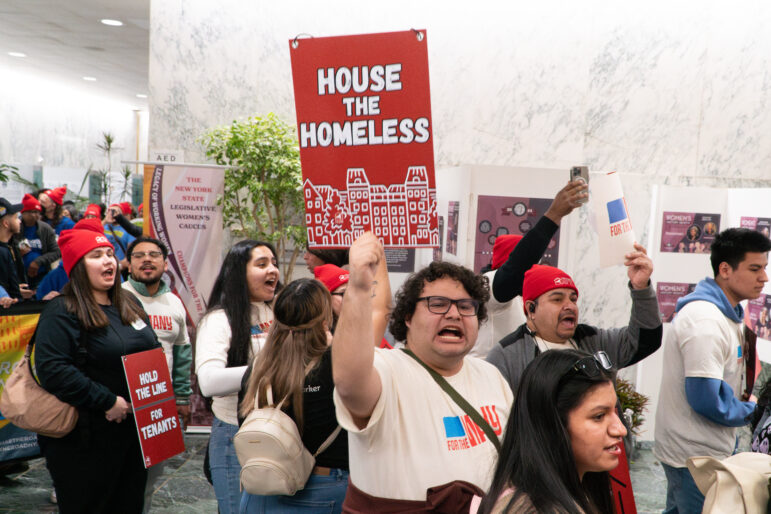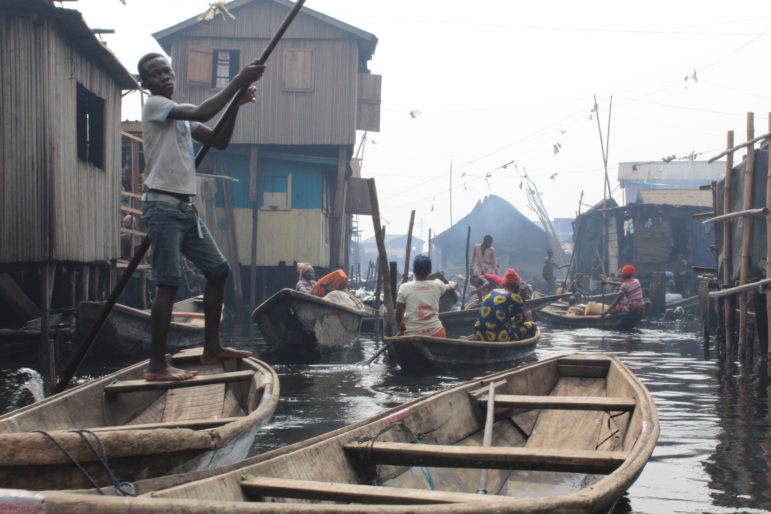
Linus Unah
An informal settlement on the edge of the Lagos Lagoon, Makoko’s waterways bustle with human activity.
This story is the first in a five-part series about displacement and the advocates who are battling it around the world.
* * * *
Zangan Satowaku felt a thrill of exhilaration when he left his home in neighbouring Benin Republic headed to Nigeria’s largest city Lagos in search of a better job and decent living. That was in 1982, and the lagoon covered much of the land around it.
Then 33, Satowaku was brimming with energy and hope. After working for more than a decade as a timber contractor in Lagos with little pay, he decided to settle in Makoko, a fishing settlement founded in the 19th century by immigrants from the Egun ethnic group. His life took on a quiet outlook, and his family began to scrape by on his earnings as a fisherman.
Throughout the two decades he lived in Makoko, home to wooden homes precariously perched on stilts on Lagos lagoon, Satowaku never had any reason to worry about the threats of eviction.
He does now.
On July 16, 2012, the Lagos state government descended on the settlement and began to tear down dwellings on the waterfront area. Satowaku, who is one of the local chiefs there, watched as thousands of people were forced to move inland.
A policeman even shot and killed a community leader—Timothy Huntoyanwha, who, residents say, dared to ask officers the reason for the forced evictions. In the area that was demolished, a wooden cross with a plastic crucifix fixed on the top remains, totally unmoved by the flow of the lagoon. People gather here every year to pray for Huntoyanwha and for the slum not to fall to the machinations of the state authorities.
Before the demolition, the Lagos State Ministry of Waterfront Infrastructure Development had issued a 72-hour quit noticeto residents, saying their “unwholesome structures on the waterfront” comprised nothing short of an “environmental nuisance”.
Betty Abah, founder of Lagos-based child’s right and development organization CEE-HOPE, visited the slum in the wake of the destruction. “The state of children that I saw then deeply traumatised me,” Abah told me. “I couldn’t and I still can’t fathom, reconcile or wrap my head around the indignity, the extreme poverty and misery I witnessed in Makoko.”
After the demolition of the waterfront area, dozens of shacks built on stilts were torn down, and activists estimated that tens of thousands of people (some estimates say 30,000) were forced out of their homes and pushed to the inland area of Makoko.
A week later, thousands of Makoko settlement dwellers hopped into buses and rode to the governor’s office in Alausa, where the seat of the Lagos state government is located with a bustling central business district. In the sweltering heat, they howled and stood at the entrance of the office for hours until the governor spoke to them.
“We owe you a duty, but we also owe the greater part of Lagos a duty,” Nigeria’s minister of power and housing Babatunde Fashola, then governor of Lagos, toldthe embittered crowd.
He said part of the decision to clear the waterfront area was to save the lagoon from shrinking any further as settlers encroached on it, but also added that there were illegal migrants from Cameroon, Benin Republic and Togo staying in Makoko.
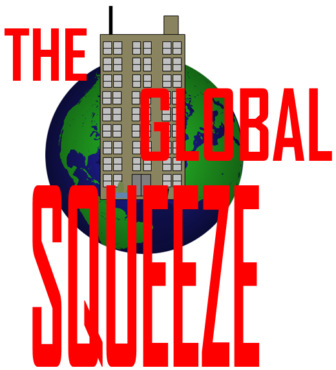
A year after homes on Makoko waterfront fell, Badia East, a small swampland housing about 30,000 people in central Lagos, became the next target. In February 2013, forced evictions there left at least 15,000 people or more homeless to make way for high-rises. Then in 2015, the authorities visited again and rendered a further 1,000 residents homeless.
“Lagos is not treating us well,” says 65-year-old Benedict Sagbo, who has lived in Makoko all of his life. “We don’t have anywhere else to go to if we leave here. It is not fair to tell us to leave here and go away. This place is all we have.”
Despite legal setbacks and further attempts to demolish Makoko, the settlement has so far survived the challenges of living in a city with a big housing problem. But the pressure continues to grow.
Makoko draws a lot of strength from its diversity. It hosts several riverine communities along the coast, covering at least six villages or communities whose homes spiral from the waterways to inland. There is Oko Agbon, Adogbo, Migbewhe and Yanshiwhe – all of which are on water—as well as Sogunro and Apollo.
Collectively called Makoko-Iwaya Waterfront, these villages share commonalities as fishermen and speak the Yoruba language, the lingua franca of southwestern Nigeria. People here also speak French and Egun. It’s common to hear “Merci” (or thank you in French) hollered around, a testament to some of the people’s origins from Togo and Benin Republic.
In Makoko, dugout canoes are the main means of transportation. Half-naked children and women mostly row their way through murky canals around the settlement. Inside this slum, there’s everything on water: churches, women with canoes filled with food and household items, barbershops, seamstresses, makeshift photo studios, auto mechanics, and many more.
“The only thing you might not see here is a grave,” 42-year-old Remy Tohoume, one of the youth leaders in the slum, said. Lagos’ new residents might be drawn to the water’s edge, but its cemeteries are on drier land in the city’s interior.
Nobody knows the exact number of people living in the settlement, but with most families having children ranging from four to as much as 16, estimates suggest that there could be up to 300,000 dwellers in Makoko.
Most people here depend on fishing, cutting timber and sand dredging—which produces material for cement-mixing at building sites—to survive.
It is not an easy fight. While Makoko’s residents have fought to preserve because it is all they have, no resident would deny that the settlement has severe needs.
From a lack of access to adequate healthcare to clean water, to sanitation and to decent schools, residents in Makoko already have plenty problems knocking on their doors as they rise from their beds every morning.
“Look around and you will see children with broken legs, malnourished infants, sick people and people defecating on the water,” 57-year-old Samuel Gomez, a father of 10, said. “We need help. If not, diseases will kill us here.”
Informal clinics and traditional birth attendants help to provide basic treatment for people in the slum as decrepit blocks of classrooms scattered all over the slums provide education. In some of these schools, children pay a token every day to enable the teachers buy chalk and textbooks.
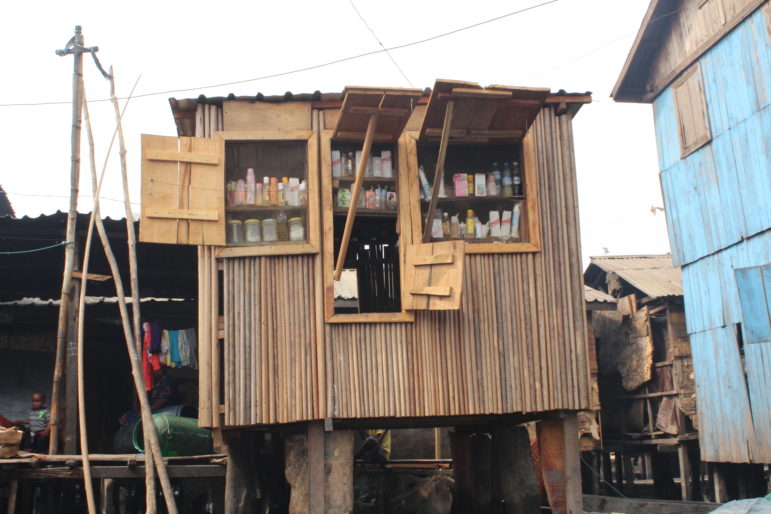
Linus Unah
A shop in Makoko.
The aim was to create “neighborhood hotspots” consisting of a network of decentralized facilities offering a rainwater harvesting system, biogascooking, kiosks, plant and toilets, as well as renewable energy production, floating markets, recycling stations, walk-in clinics, urban gardening, among others.
The plan, which was designed by Zurich-based urban design and planning agency Fabulous Urban, was drafted with support from slum-focused legal advocacy group Social and Economic Rights Action Centre (SERAC) and the Heinrich Böll Stiftung Nigeria. The regeneration plan was submitted to the Lagos state government in February 2014 for implementation. It halted further demolition for a time, but the authorities showed no interest in actually adopting it.
Though authorities continue to issue weak explanations for the demolition of shanties, like the presence of criminals and public safety problems, there is a bigger problem that none of the officials here would agree to admit: Lagos is facing a huge housing crisis amid a drive for urban development.
With most landlords requiring annual rent payments, most of the residents just can’t afford to pour their entire savings into securing a place to lay their heads. The result is that affordable housing eludes vast numbers of of people in this city of about 23 million. In targeting the lagoon settlements, the government is targeting a symptom of the housing crisis rather than the underlying disease.
“It’s truly a shame,” says activist Abah, “that Lagos cannot provide affordable housing for its urban poor and would have to visit them with extreme brute force and sheer violence routinely in the name of forced eviction.”
In a bid to beautify Lagos and encourage rapid redevelopment, the authorities are not resting on their laurels yet.
Last year, about 30,000 residentsof the Otodo Gbame waterfront slum in the city were left homeless after their homes were razed down as security forces used teargas and gunfire to force residents to flee. This happened despite a court ruling saying such demolitions would be “inhuman” and asked for negotiation with the communities.
On October 9, 2016, after a visit to Ilubirin, a waterfront community, Lagos State Governor Akinwunmi Ambode called for the demolitions of shanties in the state. Even lawmakers in Lagos House of Assembly cautionedthe government against that plan. Justice & Empowerment Initiatives – Nigeria (JEI), a nonprofit working with the waterfront communities, filed a case on behalf of residents.
The following month, a Lagos high court granted a temporary injunction restraining state authorities and the police from demolishing waterfronts identified in the suit. But the state government acted in defiance of the court order and razed the Otodo Gbame community two days after the court order. On January 26 of last year, the Lagos State High Court ruledthat the demolition waterfront communities was inhuman and unconstitutional.
“I find the eviction/threat of forcible eviction of any citizen from his home at short notice and without any immediate alternative accommodation or sufficient opportunity to arrange for such alternative accommodation before being evicted from his current abode [is] totally undignifying and certainly inhuman, cruel and degrading…” Justice Adeniyi Onigbanjo of the Lagos State High court ruled. In his final ruling in June 2017, Onigbanjo ordered the Lagos state government to stop evictions and pay compensation. “It will be wrong for them to be forcefully evicted from a land they have been [on] for several years,” Onigbanjo said.
The government immediately appealed the verdict and said that Onigbanjo’s pronouncements could encourage “illegality”. It has ignored the ruling.
“These ruthless forced evictions are just the most recent examples of a practice that has been going on in Nigeria for over a decade in complete defiance of international law,” Osai Ojigho, Amnesty International’s country director for Nigeria, said of the demolition of Otodo Gbame.
“For the residents of these deprived communities, many of whom rely on their daily fish catch to make a living, the waterfront represents home, work and survival. Forced evictions mean they lose everything – their livelihoods, their possessions and in some cases their lives.”
Most of the displaced people in Otodo Gbame are now living in Makoko, around 30,000 of them. Activists say the demolition of informal settlements on the lagoon could render at least 300,000 people homeless.
Though more pronounced in Lagos, forced evictions of slum dwellers happens across the country. For example, in 2011, hundreds of people were evicted from their homes in the Panteka settlement and market in the Nigerian capital city Abuja.
And in the oil hub of Port Harcourt, hundreds of thousands of people dwelling in the waterfront live under constant threat of eviction. Between 2009 and 2012, authorities in Port Harcourt forcibly evicted about 30,000 people in Njemanze waterfront and Abonnema Wharf as part of its urban renewal program . Usually, the tactic is for machete-wielding tough guys to storm these communities alongside armed police and soldiers who watch as structures are burnt down.
Nothing better demonstrates Nigeria’s housing deficit, estimated to be at more than 17 million units, than the evictions of poor people from slums. Since 2000, more than 2 million people have been forcibly evicted from their homes in different parts of Nigeria, according to Amnesty International.
“Such evictions generally target marginalized people and slum dwellers, many of whom have lived for years without access to clean water, sanitation, adequate health care or education,” the group said in a statement.
This is a problem that resonates well beyond Nigeria. The growth of informal settlements in cities with large populations could be blamed on the lack of affordable housing, with an increasing number of people unable to buy, rent or build formal housing, according to the 2015 World Migration Report.
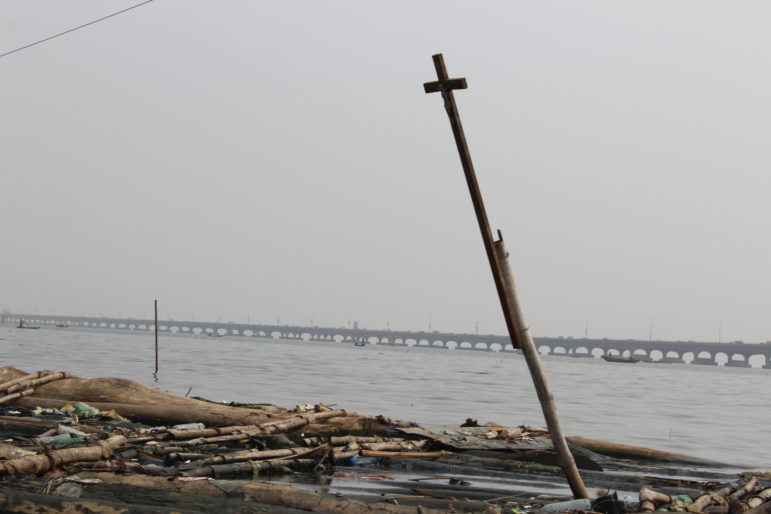
Linus Unah
The wooden cross standing where activist Timothy Huntoyanwha was shot.
The bustling thoroughfares which run into the slum brim with activities, as buyers and sellers and motorcycle taxis create the perfect Lagos street scene, filled with a lot of hubbub.
As he drives around Lagos, Remy Tohoume looks at the posh neighborhood of Ikoyi, the affluent Lekki peninsula, and the glitzy capital of Ikeja and his mind wanders in and out of thoughts surrounding the future of Makoko.
With authorities rolling out more plans to develop and beautify Lagos to make it thrilling and exciting for tourists, foreign investors and businessmen, Makoko will always be a target. But despite his worries, Tohoume and several others in Makoko disregard this palpable threat and find ways to carry on with their lives.
In 2016, they started what they called Makoko Day to celebrate among themselves. On this day, nobody goes anywhere. From a 100-meter race to football competition to a special sanitation drive to clean up the settlement and beauty contests, Makoko residents will witness a variety of activities meant to forge a sense of togetherness and joy.
This year, on March 31, the slum dwellers converged in narrow streets and the main roads that run into the settlement were closed for a big celebration. Music blared from speakers and cars, and people danced and cheered with gusto. There was a lot of food, too. This celebration thrived in spite of their worries.
Satowaku watched as people streamed in and out of his windowless wooden home on the inland area of Makoko. “This celebration makes people go crazy here,” he said slumped over a plastic chair.
“Give me a bottle of hot drink [homemade gin mixed with herbs],” a young man in traditional menswear and white shoes told him.
Satowaku shook a bottle brimming with gin and shards of herbs that moves about like a group of fish in an aquarium. He emptied some drops of the gin into a 7-ounce plastic whiskey cup and handed it over to the man, who received it, and gulped down everything.
“The government thinks of Makoko as a slum, but we see this as our home. This is where many people grow up, raise families and die. I cannot imagine myself and my friends going elsewhere.”
Linus Unah is a Nigerian freelance journalist. His work has been published in the Guardian, IRIN News, the Christian Science Monitor and NPR, among others. He writes about global health, conflict, agriculture and development. Follow him @linusunah.






